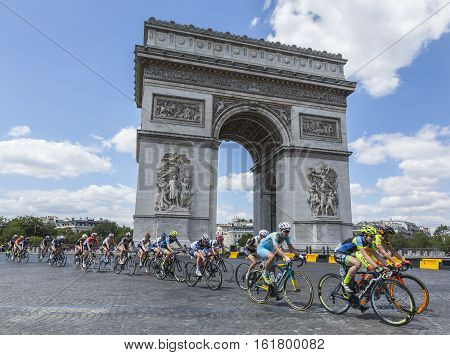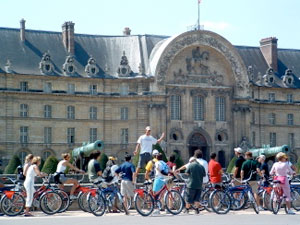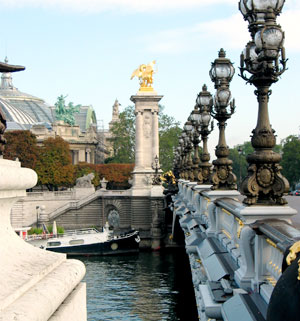PARIS – Very few visitors rent a car in Paris – “much too dangerous. Too many crazy drivers,” says my guide Romy as he assembles a small tour group outside the cycle shop at 37 Boulavard Bourdon, across from the new Paris opera.
“Oh, and cycling is safer?” I ask sarcastically.
“Mais oui,” responds an indignant Romy. “I ride my bike to work every day – never had an accident.”
As the last of the daredevil tourists saddles up on the rental bikes, Romy shouts the command “allez, allez” and we push off into the hectic Paris traffic.
“Follow me,” says Romy over his shoulder as he turns off one of Paris’ wide boulevards into a labyrinth of narrow streets, where cycle path markers painted on the pavement guide us.

Above: The most famous cyclists in Paris are the ones in the Tour de France.
The sights and smells of Paris are all around us – freshly baked bread and patisseries are being gobbled up by the locals huddled in sidewalk cafes; street cleaners in their bright green uniforms sweep up the garbage left behind by late-night revelers; dogs bark at the cycle intruders… We pass the Place de la Bastille, the former site of France's infamous prison, now an intersection dominated by the new Opera Bastille, and ride under a great arch and into a small park ringed by a collection of beautiful Parisian apartments. This was Place des Vosges and Romy signalled it was our first stop. We all dismounted - none the worse for wear.
We are in the heart of Le Marais (Marais means swamp), Romy informs us, swampland that was reclaimed and turned into the city's first square in the early 1600s as a sort of housing development for aristocrats. King Henri IV lived in the first house built here, and a giant marble statue of his son, Louis XIII, stands guard over the park.
"This is actually a copy of the original statue," Romy tells the group. "The first statue was made of bronze but it was melted down during the French Revolution and made into ammunition.
"If you notice, the king is dressed like a Roman emperor," says Romy while pointing to the huge figure on horseback. "You will see that a lot around Paris because French kings always demanded to be portrayed as Caesars on their statues."
Romy tells us a number of other interesting points about the square, such as the fact that all the apartments have tilted because of their swampy foundation.Moments later we are back on our bikes headed in the direction of the Hotel Sale. The neighbourhood motorists must be used to cycle tour groups because they patiently drive behind us and never once honk their horns. Patient Parisians. Hmm, Romy was right, this is a side of Paris few tourists see.
What a grand place the Sale must have been when it was built back in the 17th century as the residence of a salt-tax collector. The huge structure is now the home of the Musee Picasso but back then it was France's first townhouse complex, housing as many as 30 people per apartment.
One of the group mentions that it was nice of Picasso to donate so many paintings to the museum. Romy chuckles and responds: "Well, he, or rather his family, had little choice. They donated the paintings to the French government so they wouldn't have to pay the large inheritance taxes at the time of his death."
Romy then points down the street in the direction of our next destination, the Rue des Rosiers in what's known as the Jewish Quarter.
"The Jews were banished to this area of Paris in the 13th century," said Romy, whose group was now attracting stares from old women clutching bundles of warm baguettes. "Back then this area was outside the city walls but of course Paris finally caught up to it many years later."
The narrow streets were crammed with people, which made it much more difficult to maneuver the bikes. The walls on many of the buildings in this area still show the bullet hole scars of the Nazi occupation of Paris during World War II.
As we leave the Jewish quarter, a massive structure with huge blue, green and yellow pipes comes into view. "How could they put an oil refinery next to such an historic area," I thought as the building came ever closer. The people lining up to get into the structure made it clear this was not a public utility but a public gathering place.
"Welcome to the Georges Pompidou Centre," Romy said as we dismounted. "This place has generated much debate over the years (it opened in 1977), but it has evolved into the cultural centre of Paris (it houses some of the country's great modern works of art and one of the nation’s biggest libraries)."
"The place is grotesque," snarled Anne, one of the group, as she surveyed the building’s post-modern exterior.


Above: Cycling gets you close to all the important Paris landmarks.
"I call it Notre-Dame des Pipes," said the Parisian woman who joined our tourist group because, she says, “I like to see how foreigners view our city.”
With that, we were back on our bikes and our guide led us to more stops, including Les Halles, an underground mall - the only reminder that this was the site of the city's former central market, which opened for business in 1183. The food market was forced to the suburbs in the 1960s, much to the horror of Parisians, and was replaced by the cavernous underground shopping centre.
From there, our tour leader led us to a local street market and encouraged us to mingle with the merchants selling their wares on Rue Montorgueil. Anne and I roamed the street together and she introduced me to the taste of boudin (blood sausage) at Produits D'Auvergne, then insisted I try some cheese from a shop simply called Le Fromagerie. I declined to sample the cooked chickens hanging outside the Rotisserie Dorius but the smell of freshly brewed coffee tempted us inside the bistro Petit Carreaut.
The rest of the tour takes us past more great statues in the Place des Victoires and down narrow corridors before we reach the Palais Royale. From there, it's on to the courtyard of the Louvre.
"Wow, what a house," I think as our group stands in the shadow of a French landmark that was started in the 12th century and took another 700 years to complete.
We don't go inside (that's on our agenda for another day) but Romy points out a number of interesting aspects about the Louvre's exterior, including the fact that the controversial pyramid structure - designed by architect I. M. Pei and added to the courtyard in the 1980s to act as a welcome centre - contains more than 600 panes of crystal glass that must be cleaned every three years by acrobats.
It's time to head back to the cycle shop and Romy leads us to the cobblestone paths that line the Seine. Another historic stop is on the Rue des Jardins St. Paul, where the crumbled remains of Paris' first wall, built in the 12th century, are located. It's here that Anne bids the group farewell. "I must leave you now," she says, planting a kiss on both my cheeks. "I hope you have learned a lot about Paris and I hope we ride together another day."
Before long we are back at the cycle shop. The three-hour tour has gone by quickly and safely. Romy collects the $30 fee from each of us and offers to be our guide again on our next trip to Paris.A invitation we won’t pass up.